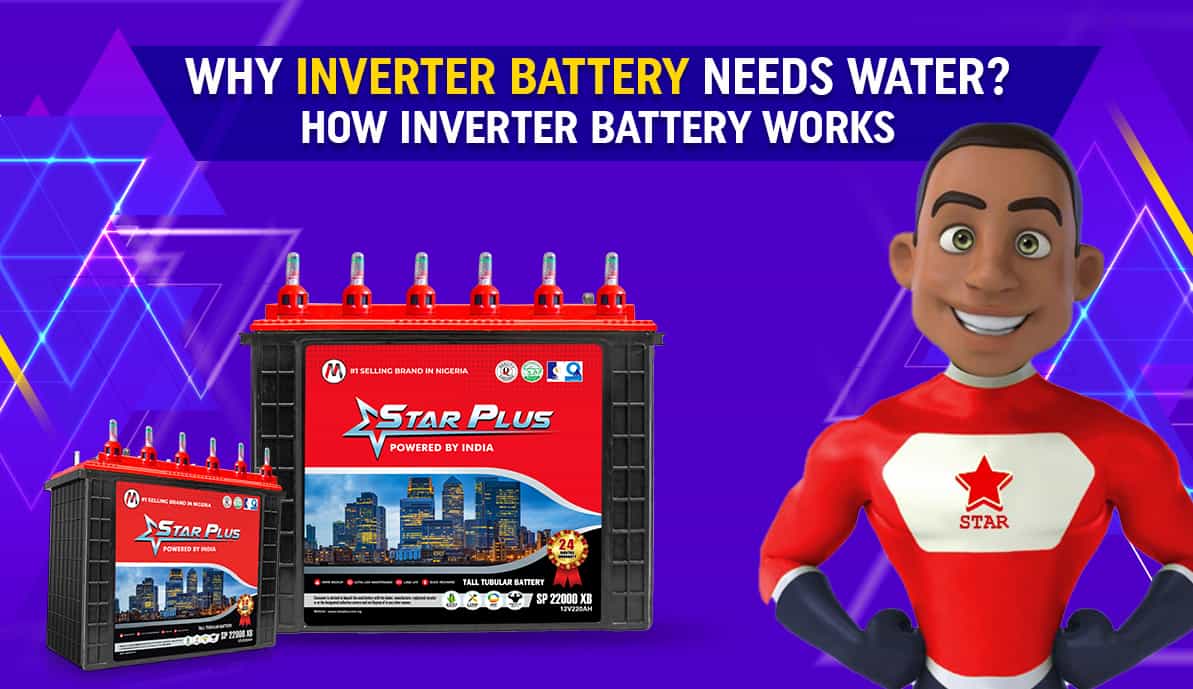Water inside a battery? Yes, your Inverter Battery has water inside it.
Inverter Batteries have become an essential component in the lifestyle of modern Nigerians. To achieve consistent performance, it is necessary to maintain the battery properly, particularly by managing internal fluid levels effectively. But why does an inverter battery need water?
If you have such questions in mind, this blog can provide you with the best answers. While some may think that regular water top can help, it’s the wrong answer.
Check out this blog to get a comprehensive idea about why water is necessary, which type of water to use, and how to use it for optimum battery life and performance.
How does an Inverter Battery work?
Before you opt to know why your inverter battery needs water, you should know how it works. Here’s a brief idea of how your tubular battery works:
- Stores Direct Current (DC) power and converts it into Alternating Current (AC) to power appliances during a power outage.
- When the main power is available, the inverter charges the battery by converting the AC into DC.
- During a power outage, the inverter draws DC power from the battery and transforms it back to AC.
Why does an Inverter Battery Need Water?
Inverter batteries rely on an electrolyte solution that is made up of water and sulfuric acid. A proper level of water is required to maintain the electrolyte solution and prevent the acid from leaking and causing damage to the battery’s internal components.
When the battery charges and discharges, the water in the electrolyte solution can evaporate. This can lead to lower water levels. If the water level lowers, the risk of battery sulphation can occur and compromise performance.
Why does an Inverter Battery Need Distilled Water?
As a user, you might wonder why inverter battery needs distilled water? Distilled water, also called Demineralized water, is the cleanest form of water.
Distilled water removes impurities, minerals, and other contaminants commonly found in tap water. Regular water contains ions and organic compounds. If you put regular water in your battery, ions block the electrodes and form layers to inhibit the chemical reactions that produce current.
Now, if you put distilled water in your inverter battery, it will not react with the electrodes or create internal functional problems. That’s why you should only use distilled water to top up your inverter battery.
Where can I get distilled water for inverter battery? You can source distilled water from your nearby hardware store or supermarket. Certain pharmacies might also keep distilled water, as it is used for some clinical purposes.
How to Check if an Inverter Battery Needs Water?
Before topping up your inverter battery with water, check if it’s the right time. Here are the significant signs that your inverter battery needs water:
1. Swelling or Bulging of Inverter Battery
Improper water levels can cause internal damage to the inverter batteries. If your battery has swelled up or bulged, it indicates a need for a water top-up. If the electrolyte level drops too low, it can cause the battery to overheat and bulge. That’s when you would need to top up your water levels.
2. Shorter Backup Time
As water in the inverter battery evaporates, the electrolyte level becomes more concentrated. This hampers the battery’s ability to store and transfer energy. A battery with low water levels will not function properly and will have a reduced backup time.
3. Low Battery Voltage
Low battery voltage is another significant indicator why does your inverter battery needs water. If the water level is low, your battery’s ability to hold a charge decreases. If you notice your inverter battery isn’t providing enough power, top it up with distilled water.
4. Corrosion around Battery Terminals
Lowering water levels can increase corrosion. A drop in water levels increases internal acid concentration levels. If you see greenish deposits around your battery terminals, it is a sign of corrosion. You need to top up your batteries with distilled water.
5. Water Level Indicator Notifying
Here comes the use for a water level indicator. At Star Plus Battery, we have introduced an Electrolyte Indicator for our tubular inverter batteries. This specially designed indicator depicts the level of electrolyte in each battery cell. By reading the indicators, you will know the current water level and how long it will sustain your inverter battery.
How to Add Distilled Water to an Inverter Battery?
After sourcing distilled water for inverter battery, learn how to add it. You can safely add water to the battery by observing the following steps:
- Wear protective gear and safety glasses so that the acid cannot touch your skin, face, or eyes.
- Ensure ventilation of the batteries and let the gases escape.
- Locate the fill caps of each inverter battery cell.
- Open each inverter battery cap with a wrench or a screwdriver.
- Use a funnel to slowly fill the battery cap with distilled water until the level is below the cap.
- Avoid overfilling, as it may cause spillage.
- Once the water level is correct, close the caps safely and check again.
Adding distilled water to your inverter battery might not be a challenging task. If you need any professional assistance, we can help you. Our installers and battery experts are right here to provide you with the best and safest water top-up solution, as and when necessary.
Want to Buy Tubular Inverter Battery for Your Home and Office?
Conclusion
We hope that this article has helped you understand more about how your inverter battery works and the role of the water level. At Star Plus Battery, we emphasize the top performance of your inverter battery.
Monitor your water levels, check whether your battery is showing any signs, and seek professional guidance if required. Connect with Us today for more details about using water in your inverter battery.
Let us know in the comments below about any other product and purchase-related queries.




0 Comments